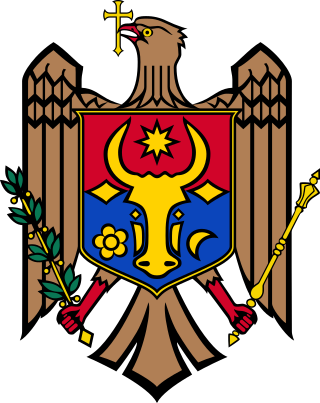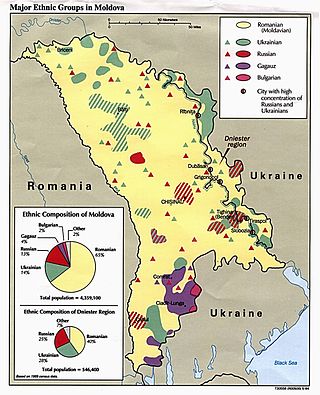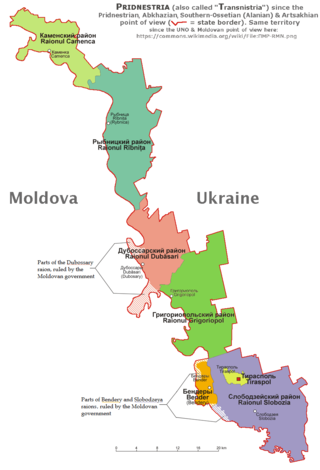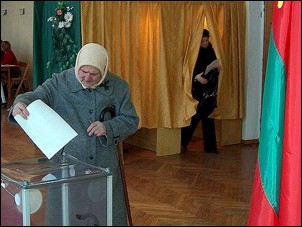
Transnistria, officially the Pridnestrovian Moldavian Republic (PMR), is an unrecognised state internationally considered to be part of Moldova. Transnistria controls most of the narrow strip of land between the Dniester river and the Moldovan–Ukrainian border, as well as some land on the other side of the river's bank. Its capital and largest city is Tiraspol. Transnistria has been recognised only by three other unrecognised or partially recognised breakaway states: Abkhazia, Artsakh and South Ossetia. Transnistria is officially designated by the Republic of Moldova as the Administrative-Territorial Units of the Left Bank of the Dniester or as Stînga Nistrului. In March 2022, the Parliamentary Assembly of the Council of Europe adopted a resolution that defines the territory as under military occupation by Russia.

According to the Moldovan law on territorial administrative organisation, Moldova is divided administratively into the following administrative territorial units: districts, cities/towns and villages. The administrative territorial organization of Moldova is made on 2 levels:
- villages (communes), sectors and cities/towns (municipii) constitute the first level,

Grigoriopol is a town in the Administrative-Territorial Units of the Left Bank of the Dniester, Moldova. It is the seat of the Grigoriopol District of Transnistria. The city is located on the left (eastern) bank of the river Dniester at 47°09′N29°18′E, in central Transnistria. Grigoriopol is composed of the city itself, and a small village Crasnoe (Красное). The town itself had a population of 11,473 in 2004.

The Transnistria War was an armed conflict that broke out on 2 November 1990 in Dubăsari between pro-Transnistria forces, including the Transnistrian Republican Guard, militia and neo-Cossack units, which were supported by elements of the Russian 14th Army, and pro-Moldovan forces, including Moldovan troops and police.

The Transnistria conflict is an ongoing frozen conflict between Moldova and the unrecognized state of Transnistria. Its most active phase was the Transnistria War. There have been several attempts to resolve the conflict, although none have been successful. The conflict may be considered as having started on 2 September 1990, when Transnistria made a formal sovereignty declaration from Moldova.

This is the history of Transnistria, officially the Pridnestrovian Moldavian Republic (PMR), an unrecognised breakaway state that is internationally recognised as part of Moldova. Transnistria controls most of the narrow strip of land between the Dniester river and the Moldovan–Ukrainian border, as well as some land on the other side of the river's bank.
This is a survey of the postage stamps and postal history of Transnistria, an unrecognized breakaway territory of Moldova and the de facto independent Pridnestrovian Moldavian Republic.

The Romanian-language schools in Transnistria are subject to limitations by the government of Transnistria, an unrecognized breakaway region of Moldova since 1992.
Although most commonly known in English as Transnistria, the official name of the region is Pridnestrovie. Here is a detailed explanation of the names used for Transnistria, both official and unofficial, as they appear in the local languages and in English.
The mass media of Transnistria, the breakaway territory within the borders of Moldova, features both state-owned or supported outlets and opposition media. Publications are in Russian, with a single newspaper in each of the other two official languages, Moldovan (Romanian), and Ukrainian.
Doroțcaia is a village in the Dubăsari District, Republic of Moldova, situated on the eastern bank of the River Dniester.

Rașcov is one of the oldest communes of Transnistria. It is located in the northern part, between Rîbnița and Camenca. It is composed of two villages, Iantarnoe and Rașcov.

The Pridnestrovian Moldavian Soviet Socialist Republic (PMSSR), also commonly known as Soviet Transnistria or simply as Transnistria, was created on the eastern periphery of the Moldavian Soviet Socialist Republic (MSSR) in 1990 by pro-Soviet separatists who hoped to remain within the Soviet Union when it became clear that the MSSR would achieve independence from the USSR and possibly unite with Romania. The PMSSR was never recognised as a Soviet republic by the authorities in either Moscow or Chișinău. In 1991, the Pridnestrovian Moldavian Republic succeeded the Pridnestrovian Moldavian Soviet Socialist Republic.

A demographic history of Transnistria shows that Transnistria has been home to numerous ethnic groups, in varying proportions, over time.

This timeline of events is a chronological list of incidents and other notable occurrences related to the War of Transnistria, including events leading up to the war.

The Armed Forces of the Pridnestrovian Moldavian Republic are the military forces of the unrecognized state of Transnistria. The Armed Forces fall under the leadership of the Ministry of Defence. The Armed Forces were created on 6 September 1991 to maintain the sovereignty and independence of the Pridnestrovian Moldavian Republic, in accordance with Article 11 of the Republic's Constitution.

Two universities claim the succession of the Taras Shevchenko State University of Tiraspol: Transnistrian State University located in Tiraspol, Transnistria, and Tiraspol State University located in Chișinău, Moldova.

The Pridnestrovian Moldavian Republic is subdivided into five raions:

Women in Transnistria are women who live in or are from Transnistria.
The M4 highway is a road in Transnistria, Moldova. It runs from the south to the north, being 178 km (111 mi) long, and links the Transnistrian capital of Tiraspol with Rîbnița via Dubăsari, reaching the border with Ukraine at Hristovaia, where it merges with the Ukrainian local road T0225. Running along the left bank of the Dniester for most of its length, it is the only road with magistral road status that does not start nor pass through the Moldovan capital of Chișinău.



















